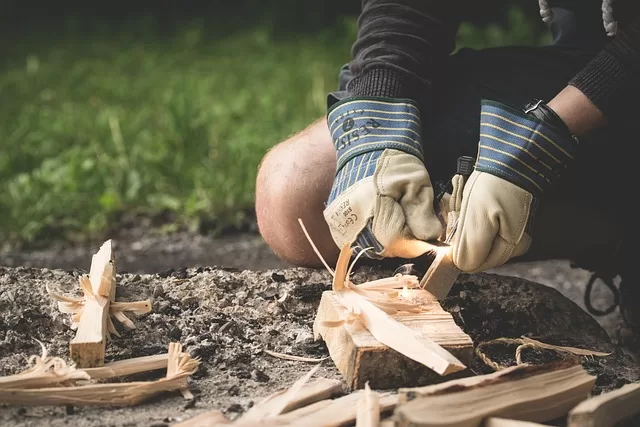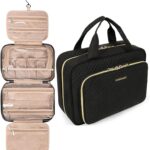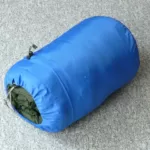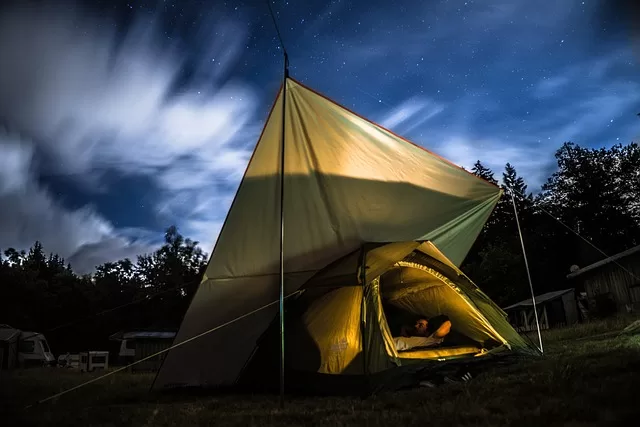Whether you’re an experienced camper or just starting and don’t know how to camp alone, this piece is the ultimate guide you need for building the perfect campfire. You know there’s nothing quite like the warmth and ambiance of a crackling campfire. It is a quintessential part of the outdoor experience, which provides warmth, light, and a cozy atmosphere for camping and outdoor activities. However, building a campfire can be challenging, especially for beginners. Here are some tips and tricks to help you build a campfire that’s not only beautiful and cozy but also safe and sustainable when you find yourself in the great outdoors.
Just so you know, this article is here to let you see how building the perfect campfire takes more than just throwing some logs on the ground and lighting a match. It is filled with the right techniques and will encourage you to add a little practice, to create the perfect campfire for your next outdoor adventure. From choosing the right materials to building the fire properly, I’ve got everything outlined here for building the perfect campfire.
Hey! Don’t you want to grab your marshmallows and firewood already, so that we can get started on this journey to building the perfect campfire?
How to Choose the Right Fire Starter and Kindling
Choosing the right fire starter and kindle is one of the first steps to making the perfect campfire as it’s what will make the difference between a sparkling crackling fire and frustration. There are some factors to consider when choosing a starter or kindling to have a safe and sustainable fire and they include:
Your Needs and Preferences
Some people prefer different firestarters for various reasons peculiar to them. There is really no firestarter without its own pros and cons so pick one that best suits your needs and preferences. For example, matches are easy to use but can be prone to wind or moisture, while fire starters are more reliable but require more skill to use.
Quality of Material
Always opt for light materials. They will help you get your fire going quickly and keep it burning steadily. Some of the best firestarters options include dryer lint, paper towels, or cardboard egg cartons. For kindling, try using small twigs, pine cones, or sticks that have been split into thin strips.
Availability of Material
It’s also a good idea to choose firestarters and kindling that are easy to find and collect in your camping area. For example, if you’re camping in an area with a lot of pine trees, using pine cones as kindling can be a good choice. On the other hand, if you’re camping in a more arid area, it might be harder to find dry twigs and sticks, so you may need to bring your own fire starters and kindling.
Environmental Impact of Choice
it’s also important to always consider the environmental impact of your choices. If you’re concerned about the environment, try to choose firestarters and kindling that are biodegradable and won’t leave any lasting impact on the area where you’re camping.
How to Choose the Right Location for Your Campfire
It is crucial to choose the right location for your campfire for several reasons. And to choose this perfect location, you have to consider certain factors like:
Local Fire Regulations
Did you know that certain areas have fire regulations? So it’s important to do your research and follow local fire regulations and obtain any necessary permits. Yes, there are several regulations and restrictions on fire buildings to prevent accidents and safeguard the environment.
Type of Area
Another thing to consider is the area, and I mean the surface of the ground. It is sloppy, or flat? A flat area for your campfire is the best choice here. This will help to prevent the fire from spreading, and will also make it easier for you to control and manage the fire. Another aspect of the area is making sure that it is away from flammable materials, such as dry grass or leaves, to further reduce the risk of the fire spreading.
The Direction of the Wind
Always opt for an area that is protected from strong winds, because winds can cause the fire to spread or become difficult to control.
The Proximity of Your Campfire to Water Sources
All though this isn’t so important because you can always use the water in your can, it’s actually a good idea to consider the proximity of your campfire to water sources, such as a river or lake. Having access to water can be helpful in case you need to put out a fire quickly and your can of water may not be enough.
Steps to Building the Perfect Campfire

To build that perfect campfire, you need to follow a step-by-step approach and here are all the steps involved in building the perfect campfire:
Choose an Area
Of course, the first thing to do would be to pick an area to make your fire. This means choosing an open area away from any trees, bushes, or other flammable materials. You should also confirm to make sure that the area you have chosen isn’t restricted.
Gather Fire-Building Materials
You will need to gather materials to build your campfire. Bring all the materials you will need to build your campfire to the spot where you intend to start your fire.
Clear the Area
You need to clear the area to keep it safe and prevent any fire hazards. Also, one of the most important things for building the perfect campfire is a good base for your fire. To get that, you must first clear the area. Start by clearing away any leaves, grass, or other debris from the area where you want to build your fire.
Build a Good Base
After you have cleared the grass and debris and gotten the ground set, use small sticks and twigs to create a circular or square shape on the ground. This will be the foundation of your campfire and what is called a base. Once you have your base, it’s time to start adding tinder to your fire. Tinder is any small, dry, and flammable material that can help to ignite your fire. Some good examples of tinder include dry leaves, newspaper, or other small twigs and sticks. Add a small handful of tinder to the center of your base, making sure to leave enough space for air to circulate around it.
Light Your Campfire
After all, has been set, go ahead to light your fire. This will require some patience and gentleness, to allow the tinders to catch the fire and begin to burn. Protect the flame from the wind to make it steady. This can be done with a match, a lighter, or even a battery-powered firestarter. Be careful when lighting your fire, and make sure to keep a close eye on it at all times.
Add Larger Sticks
Once your tinder is lit and your fire starts, carefully add larger sticks and logs to the fire, starting with the smallest and working your way up to the largest. This will help to create a strong, stable fire that will last for hours.
Different Campfire-Making Methods

Did you know that there are several methods for making and maintaining a fire? Each method has its own unique set of steps and benefits, so choosing any method will depend on how you want your fire to be. Here are the three common methods:
The Teepee Method
Making fire using the Teepee method would have you first create a small pile of kindling and twigs in the center of your fire pit. Then, you arrange the larger logs or branches around the kindling in a teepee shape, leaving an opening at the front for oxygen to flow in and help the fire burn. Once your teepee is in place, light the kindling and carefully feed the fire with more fuel as needed to keep it going.
This method allows for airflow and makes the fire burn more brightly and freely without smoke.
The Log Cabin Method
For the log cabin method, create a small pile of kindling and twigs in the center of your fire pit. Then, stack the larger logs or branches around the kindling in a log cabin shape, with each log resting on top of the one below it at a right angle. Make sure to leave an opening at the front of the cabin for oxygen to flow in and help the fire burn. Once your log cabin is in place, light the kindling and carefully feed the fire with more fuel as needed to keep it going.
This method allows for a more long-lasting fire that can help you stay for a long engaging in all the fun things you have to do while camping at night.
The Cross-Ditch Method
This fire-making method involves digging a small pothole in the center of your fire pit and filling it with kindling and twigs. After that, you arrange the larger logs or branches in a cross shape over the ditch. Let each log rest on top of the ditch at a right angle to the one next to it. Just like the other methods, be sure to leave an opening at the front of the cross for oxygen to flow in so that the fire can burn.
Once everything has been set following this process, light your kindling in the pothole you made and after it is lit, carefully feed the fire with more fuel as needed to keep it going, till it burns fully and your campfire is made.
This method allows your fire to burn more evenly and not be put out quickly. It is the best method to opt for while camping in the rain for a more sustainable campfire that stands the weather.
Tips and Tricks for Building and Maintaining a Campfire
You know you can’t just learn and practice building the perfect campfire without maintaining it to help you engage freely in fun camping activities with friends and camp buddies and not have your fun cut short halfway. To do this, you need to know some tips and tricks for sustaining the fire and they include:
Choosing a Good Location
Always choose a good location for the campfire and by good location, I mean choosing a safe location for your campfire, away from low-hanging branches, dry leaves, and other flammable materials. Clear an area around the fire pit of any debris, and make sure there is a source of water nearby in case the fire needs to be extinguished.
Arranging Your Firewood
You should arrange your firewood using any of the fire-making methods that suit your camping goals. This means that it will be done depending on how you hope your fire will be, which of course will be influenced by the fun things you hope to do while camping at night, or if camping in the rain, with friends, or camping with family or if on solo camping and will engage in some fun things while camping alone.
Using Firestarters
You will always need fire starters or paper to help get the fire started. For an even quicker trick, use dryer lint or birch bark shavings, which are highly flammable and will help the fire to catch quickly.
Adding Large Logs Later
Don’t use large logs of wood to start your fire and do well to avoid using green wood, as it is harder to ignite and will produce a lot of smoke. You should only add larger wood as the fire comes on stronger and steadier.
Maintaining a Perfect Fire You Can Control
Don’t go with the flow and make a kind of fire that you cannot control. It’s best to make sure that the fire is not too large because a fire that is too large can be difficult to control and may produce too much heat, which poses a threat or become hazardous. However, if you can maintain a large fire, then you can go ahead but it is best to be safe than regret.
Keeping an Eye on the Fire at All Times
No matter how cozy the night or fire gets or interesting the activities become, never leave the fire unattended; always keep an eye on it. A campfire can easily get out of control if it is left unattended, and it can pose a serious safety hazard. Also, not watching the fire can also make it trip off and cut short your fun or put you through the stress of making another fire so constantly use a stick or a poker to move the logs around and keep the fire burning evenly.
Allow Airflow
One of the most important things to remember is that your campfire needs oxygen to continue burning, so it’s important to make sure that there is enough airflow around the fire to provide it with the oxygen it needs. This will involve poking the fire every now and then and leaving a space in the middle for air to flow.
Add Fuel Strategically and Safely
The best way to add fuel is to first break it into smaller pieces and add them in bits, which will allow it to burn more evenly and safely, as well as provide more surface area for the flames to consume.
Always Follow Local Fire Rules and Regulations
Always do your research before starting a fire, and make sure to follow the rules.
Use Water or Sand to Extinguish the Flame
When you are ready to put the fire out, use water or sand to extinguish the flames completely. Make sure the fire is completely out before leaving the campsite.
Tips for extinguishing Your Campfire properly
To avoid causing any form of fire accident or getting injured because you probably didn’t extinguish your fire properly, here are some useful tips for extinguishing a campfire:
Allow the Fire to Burn Down
Don’t just pour water into a large burning fire, let the fire burn down to a bed of glowing embers. This will make it easier to extinguish the fire and will also reduce the amount of smoke that is produced.
Spread the Embers out
Once the fire has burned down to embers, use a shovel or other tool to carefully spread the embers out, again, don’t just pour water on the embers. Spreading the embers exposes them to more air and makes it easier to extinguish them.
Pour Water Over the Embers
After you have spread the embers, you can now carefully pour water over them, making sure all have been properly extinguished by the fire.
Stir the Embers
Stir the embers after pouring water on them, this ensures that all of the hot spots have been extinguished.
Keep Adding Water
Continue to add water and stir the embers until you are sure that the fire is completely out.
Safely Dispose of the Embers
Once you are certain that the fire is out completely, scoop up the ashes and embers and safely dispose of them.
Do a Routine Check on the Area Again
Finally, make sure to check the area carefully for any remaining hot embers or smoldering debris that could potentially reignite the fire.
Conclusion
Building the perfect campfire is truly an art that involves processes and steps. It is obviously not just about gathering some sticks and lighting a match, but a delicate art that requires a perfect blend of patience, knowledge, skill, and practice to get it done right.
The methods you choose to make your fire will depend on your camping activities goal, for example, if looking to enjoy some fun couple camping activities by a campfire, you will be needing a slow and steady lasting fire to give that cozy ambiance and the log cabin method seems like the perfect method here. However, the most important thing is to always use dry, seasoned wood and start with a good foundation.
I am certain that by following these tips, you can enjoy the warmth, light, and ambiance of a beautifully crafted campfire on your next camping trip. So the next time you find yourself in the great outdoors, don’t rush it, simply take your time to build the perfect campfire and enjoy the warmth, light, excitement, and coziness it brings.



























